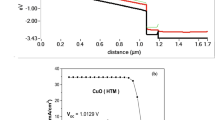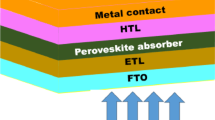Abstract
Tin (Sn)-based perovskite solar cells (PSCs) have received increasing attention in the domain of photovoltaics due to their environmentally friendly nature. In this paper, numerical modeling and simulation of hole transport material (HTM)-free PSC based on methyl ammonium tin triiodide (CH3NH3SnI3) was performed using a one-dimensional solar cell capacitance simulator (SCAPS-1D) software. The effect of perovskite thickness, interface defect density, temperature, and electron transport material (ETM) on the photovoltaic performance of the device was explored. Prior to optimization, the device demonstrated a power conversion efficiency (PCE) of 8.35%, fill factor (FF) of 51.93%, short-circuit current density (Jsc) of 26.36 mA/cm2, and open circuit voltage (Voc) of 0.610 V. Changing the above parameters individually while keeping others constant, the obtained optimal absorber thickness was 1.0 μm, the interface defect density was 1010 cm–2, the temperature was 290 K, and the TiO2 thickness was 0.01 μm. On simulating with the optimized data, the final device gave a PCE of 11.03%, FF of 50.78%, Jsc of 29.93 mA/cm2, and Voc of 0.726 V. Comparing the optimized and unoptimized metric parameters, an improvement of ~ 32.10% in PCE, ~ 13.41% in Jsc, and ~ 19.02% in Voc were obtained. Therefore, the results of this study are encouraging and can pave the path for developing highly efficient PSCs that are cost-effective, eco-friendly, and comparable to state-of-the-art.








Similar content being viewed by others
References
Danladi E, Salawu AO, Abdulmalik AO et al (2022) Optimization of absorber and ETM layer thickness for enhanced tin based perovskite solar cell performance using SCAPS-1D software. Phys Access 2(1):1–11
Zadeh NJ, Zarandi MB, Nateghi MR (2019) Optical properties of the perovskite films deposited on meso-porous TiO2 by one step and hot casting techniques. Thin Solid Films 671:139–146
Safari Z, Zarandi MB, Nateghi MR (2019) Improved environmental stability of HTM free perovskite solar cells by a modified deposition route. Chem Pap 73(11):2667–2678
Kojima A, Teshima K, Shirai Y et al (2009) Organometal halide perovskites as visible-light sensitizers for photovoltaic cells. J Am Chem Soc 131(17):6050–6051
Green MA, Ho-Baillie A, Snaith HJ (2014) The emergence of perovskite solar cells. Nat Photonics 8(7):506–514
Qu Z, Ma F, Zhao Y et al (2021) Updated progresses in Perovskite solar cells. Chin Phys Lett 38:107801
Ai B, Fan ZW, Wong ZJ (2022) Plasmonic–perovskite solar cells, light emitters, and sensors. Microsyst Nanoeng 8:5
Zhi CY, Li Z, Wei BQ (2021) Recent progress in stabilizing perovskite solar cells through two-dimensional modification. APL Mater 9(7):070702
Yang TY, Jeon NJ, Shin HW et al (2019) Achieving long-term operational stability of perovskite solar cells with a stabilized efficiency exceeding 20% after 1000 H. Adv Sci (Weinh) 6(14):1900528
Danladi E, Onimisi MY, Garba S et al (2020) 9.05% HTM free perovskite solar cell with negligible hysteresis by introducing silver nanoparticles encapsulated with P4VP polymer. SN Appl Sci 2(11):1769
Luo Q, Zhang CX, Deng XS et al (2017) Plasmonic effects of metallic nanoparticles on enhancing performance of perovskite solar cells. ACS Appl Mater Interfaces 9(40):34821–34832
Sabbah H (2022) Numerical simulation of 30% efficient lead-free perovskite CsSnGeI3-based solar cells. Materials (Basel) 15(9):3229
Li SJ, Yang F, Chen MM et al (2022) Additive engineering for improving the stability of tin-based perovskite (FASnI3) solar cells. Sol Energy 243:134–141
Shockley W, Queisser HJ (1961) Detailed balance limit of efficiency of p-n junction solar cells. J Appl Phys 32(3):510–519
Jalalian D, Ghadimi A, Kiani A (2019) Modeling of a high performance bandgap graded Pb-free HTM-free perovskite solar cell. Eur Phys J Appl Phys 87(1):10101
Etgar L, Gao P, Xue ZS et al (2012) Mesoscopic CH3NH3PbI3/TiO2 heterojunction solar cells. J Am Chem Soc 134(42):17396–17399
Mohammed MKA (2020) High-performance hole conductor-free perovskite solar cell using a carbon nanotube counter electrode. RSC Adv 10(59):35831–35839
Burgelman M, Decock K, Khelifi S et al (2013) Advanced electrical simulation of thin film solar cells. Thin Solid Films 535:296–301
Liu F, Zhu J, Wei JF et al (2014) Numerical simulation: toward the design of high-efficiency planar perovskite solar cells. Appl Phys Lett 104(25):253508
Fakhri N, Salay Naderi M, Gholami Farkoush S et al (2021) Simulation of perovskite solar cells optimized by the inverse planar method in SILVACO: 3D electrical and optical models. Energies 14(18):5944
Zandi S, Saxena P, Gorji NE (2020) Numerical simulation of heat distribution in RGO-contacted perovskite solar cells using COMSOL. Sol Energy 197:105–110
Chen K, Wu P, Yang W et al (2018) Low-dimensional perovskite interlayer for highly efficient lead-free formamidinium tin iodide perovskite solar cells. Nano Energy 49:411–418
Riku C, Kee YY, Ong TS et al (2015) Simulation of mixed-host emitting layer based organic light emitting diodes. AIP Conf Proc 1657(1):070002
Kanevce A, Reese MO, Barnes TM et al (2017) The roles of carrier concentration and interface, bulk, and grain-boundary recombination for 25% efficient CdTe solar cells. J Appl Phys 121(21):214506
Klenk R (2001) Characterisation and modelling of chalcopyrite solar cells. Thin Solid Films 387(1–2):135–140
Danladi E, Shuaibu A, Ahmad MS et al (2021) (2021) Numerical modeling and analysis of HTM-free heterojunction solar cell using SCAPS-1D. East Eur J Phys 2:135–145
Lin LY, Jiang LQ, Li P et al (2019) A modeled perovskite solar cell structure with a Cu2O hole-transporting layer enabling over 20% efficiency by low-cost low-temperature processing. J Phys Chem Solids 124:205–211
Rahman MS, Miah S, Marma MSW et al (2019) Simulation based investigation of inverted planar perovskite solar cell with all metal oxide inorganic transport layers. In: 2019 International conference on electrical, computer and communication engineering (ECCE). Cox'sBazar, Bangladesh. IEEE, 1–6
Das AK, Mandal R, Mandal DK (2022) Impact of HTM on lead-free perovskite solar cell with high efficiency. Opt Quant Electron 54(7):455
Mehmood U, Al-Ahmed A, Al-Sulaiman FA et al (2017) Effect of temperature on the photovoltaic performance and stability of solid-state dye-sensitized solar cells: a review. Renew Sustain Energy Rev 79:946–959
Jamalullail N, Mohamad IS, Norizan MN et al (2018) The effect of temperature on anatase TiO2 photoanode for dye sensitized solar cell. Solid State Phenom 273:146–153
Korir BK, Kibet JK, Ngari SM (2021) Simulated performance of a novel solid-state dye-sensitized solar cell based on phenyl-C61-butyric acid methyl ester (PC61BM) electron transport layer. Opt Quant Electron 53(7):368
Eli D, Onimisi MY, Garba S et al (2019) Simulation and optimization of lead-based perovskite solar cells with cuprous oxide as a P-type inorganic layer. J Nig Soc Phys Sci 1:72–81
Acknowledgements
The authors would like to thank Professor Marc Burgelman, Department of Electronics and Information Systems, University of Ghent, for the development of the SCAPS software package and allowing its use.
Author information
Authors and Affiliations
Corresponding author
Ethics declarations
Conflict of interest
The authors declare that there is no conflict of interest.
Rights and permissions
Springer Nature or its licensor holds exclusive rights to this article under a publishing agreement with the author(s) or other rightsholder(s); author self-archiving of the accepted manuscript version of this article is solely governed by the terms of such publishing agreement and applicable law.
About this article
Cite this article
Danladi, E., Kashif, M., Ichoja, A. et al. Modeling of a Sn-Based HTM-Free Perovskite Solar Cell Using a One-Dimensional Solar Cell Capacitance Simulator Tool. Trans. Tianjin Univ. 29, 62–72 (2023). https://doi.org/10.1007/s12209-022-00343-w
Received:
Revised:
Accepted:
Published:
Issue Date:
DOI: https://doi.org/10.1007/s12209-022-00343-w




